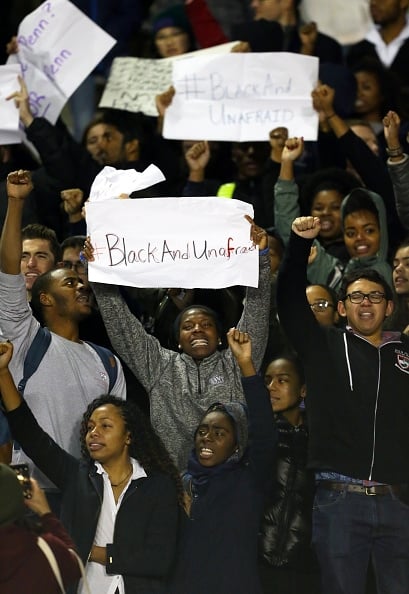You have /5 articles left.
Sign up for a free account or log in.

Students protest during a football game between Harvard University and the University of Pennsylvania.
Getty Images
With each new academic year come new racial incidents on campuses, watched closely by university administrators seeking to master the rules of response in order to cling to their jobs.
The fall 2015 unrest at the University of Missouri, which led to the resignation of the system president and one campus’s chancellor, and at Yale University, where protestors chastised an instructor about her comments on Halloween costumes, probably assisted Donald Trump’s improbable rise as a champion of the politically incorrect. Many Americans find it odd that privileged students express outrage at risqué Halloween costumes, not at terrorist attacks on their nation by notably intolerant jihadists.
No doubt some of the grassroots support for Trump reflects the alienation of rural white voters who, as J. D. Vance explains in Hillbilly Elegy, feel pitied and patronized by their nation’s political elites. Ironically, a similar alienation may explain why privileged college students of color at places like Yale seize any opportunity to express outrage. They feel patronized by their universities -- and for good reason. While institutions like the U.S. Army seem effective at bringing diverse young Americans together, higher education seems to spin them apart. So how did America’s most progressive institutions get race relations so very wrong?
I write as a right-leaning white man, but one with African-American friends and collaborators met while growing up in a blue-collar neighborhood and then spending 40-odd years in academe, teaching at a range of small and large, public and private institutions. In that time, I’ve read much and seen even more, including sensitive matters that few academics of any color address with clarity for fear of attacks.
Underlying the controversies at Yale, Missouri and, in a quieter way, at most of the 10 institutions of higher learning where I have taught, are real issues of privilege and alienation. When African-Americans complain that they are not taken seriously at colleges and universities, my fellow conservatives need to acknowledge the key reason why: African-Americans are not taken seriously at colleges and universities. Meanwhile, for their part, liberals need to acknowledge that diversity policies -- at least as actually practiced at most colleges and universities rather than in theory or public proclamation -- have walled off minorities from the centers of university life, making racial hierarchies all the steeper and inherently challenging situations still more challenging.
Way back in 1972, in Black Education: Myths and Tragedies, African-American economist Thomas Sowell wrote about the challenges facing African-American professors, who must teach and publish like everyone else but who also are drafted to serve as recruiters of and gurus to black students, as preventers of open racial conflict, as the authentic “black voices” on innumerable committees (a pretty awesome responsibility when you think about it), and in pervasive public relations roles as living proof that institutions of higher learning are diverse. As Stephen L. Carter pondered in Reflections of an Affirmative Action Baby, the omnipresent racial consciousness in academe makes minority professors and students continually unsure of whether white-dominated institutions value their skills or their skin color. That insecurity results from white privilege in the purest sense, making HBCUs all the more appealing.
In the University but Not of It
My first knowledge of this came some 30 years back, while studying in a high-octane Ph.D. program. I was the only openly Republican student in the program, my best friend for a time was the only African-American student, and our basically decent colleagues never quite knew how to react to either of us. I was young and insecure (now middle-aged and crotchety), but then, so were my peers. Possibly, the prospect of my tattling to conservative state legislators, or worse still, my friend accusing someone of racism (the latter a real career killer), put some on their guard. Such insecurities are immeasurably more pronounced in today’s time of conservative bloggers, libertarian think tanks, politically correct trigger warnings and Orwellian microaggressions.
Of course, unlike my friend, I was never called out of class to have my picture taken for a university brochure or asked to represent “the black point of view.” My friend could not just be a doctoral student in a top 10 program -- which is hard enough. He was supposed to be the minority student, a token, not a person, someone to be handled with care. He ended up leaving academe.
I, too, experienced the feeling of being in the university but not of it. On the verge of flunking out, I was exiled off the 12th floor of the social sciences tower to the second floor to share an office with the graduate students in Africana studies, a department that apparently had extra space or insufficient clout to protest. The Africana students were bright but bitter, lamenting our status of occupying the only office in the building that did not even have a phone -- that was how much the university trusted us! Everyone knew no one from there would make dean any time soon. We were the ghetto of the university, although for me it was only temporary.
Unfortunately, some 30 years later, remarkably few presidents of colleges and universities are African-American -- only about 6 percent, according to the American Council on Education, even counting community colleges and HBCUs. I know fine scholars and teachers who might receive serious consideration for serious leadership posts at Research 1 universities -- were they white. As African-Americans, they get stuck on the black track Sowell lamented back in 1972.
Fast-forward a few decades, and I heard a chancellor casually suggesting that to support ethnic diversity, the university needed to enlarge majors like education, sociology and African-American studies -- not engineering, linguistics or Arabic. Nor did this chancellor (or any I university leader I have known) talk seriously about how to push K-12 schools to reduce the racial achievement gaps that hinder the efforts of higher education (and society generally) to desegregate.
Rather, his meaning was clear: you can’t expect those black folks to have the brains to handle regular majors, so to make the diversity numbers we would create refuges (ghettos?) within the university. This particular chancellor was a decent human being and a member of the left in good standing, someone who probably never voted Republican. (Republican chancellors may well be rarer than African-American chancellors.) Yet his views of the capabilities of minorities were indistinguishable from those of the most noxious segments of the Trump movement. Those views were on public display, but far more common are quiet references in hiring committees to the effect that you just can’t expect minorities, or rather certain minorities, to cut it in academic settings.
So while I am not a person of color, from lived experience in the academy I got it when, in the Schuette case, U.S. Supreme Court Justice Sonia Sotomayor opined that “race matters because of the slights, the snickers, the silent judgments that reinforce that most crippling of thoughts: ‘I do not belong here.’”
But here is what Justice Sotomayor and many others on the left do not get. True integration in any workplace, but particularly in hypercompetitive academe, only works when people have roughly equivalent skills. Most faculty members know this, and some make largely unsupported attempts to do something about the skills gaps across groups.
But, unfortunately, that is simply not how many administrators view the issue. They practice affirmative action by admitting African-American and occasionally Hispanic students with academic skills well below those of their white and (especially) Asian peers and then exiling those students (and sometimes faculty members) to the margins of the university -- to “special” majors, programs and even dorms. In other words, they set up expectations of white and Asian privilege, and African-American disadvantage, in ways that guarantee alienation and division, however much we deny or avoid it.
What Should be Done?
As Benjamin Ginsberg argues in The Fall of the Faculty, some of our collective failure to manage diversity (and a host of other issues) reflects the fact that administrators, not professors, now dominate our universities. Higher education administrators often view diversity issues through the prisms of politics and public relations. Even though each group leans well to the left politically, approaches to diversity can divide college administrators and faculty members. In The Still Divided Academy, Stanley Rothman, April Kelly-Woessner, and Matthew Woessner offer extensive survey data showing that while college and university administrators see no downside to affirmative action, their faculty members, who actually work with students and value academics, perceive trade-offs between diversity and student success.
This is a divide between those working directly with students and those focused on “the big picture,” for whom individual students are abstractions. For most faculty members, whatever their ideology, issues of diversity offer educational challenges: How do we serve all our students, including minorities, and use diversity to enhance rather than constrict intellectual exchange? In contrast, college and university administrators by and large care little if black students (or any students) learn. For the administrators who run colleges and universities, diversity offers political challenges: How do we keep minorities quiet and have sufficient numbers of them to look good to external funders? This means that minority activists at places like Yale, the University of Missouri and wherever the next racial incident occurs in a deep sense have it right: university leaders do not care about them save as public relations objects. That’s a recipe for alienation, and rebellion.
Perhaps universities don’t have to be this way. Some of the better work on managing diversity comes out of the military, such as Charles Moskos and John Sibley Butler’s 1996 classic All That We Can Be: Black Leadership and Racial Integration the Army Way. This nuanced sociology suggests integration works best when those of different identities have roughly equal skills, face common challenges, get to know each other as individuals rather than as group representatives and cannot retreat to separate “safe spaces.” Grown-ups could structure the academic and social challenges of college in such ways. Putting more focus on academics would be a good start, unifying students around the common demands of course work. Going a step farther might mean de-emphasizing institutions of progressive privilege, like diversity programs, and even more powerful institutions of traditional privilege, like fraternities and sororities.
Unfortunately, however, the prospects for such bold, individual student foci on the part of large, bureaucratic institutions are not good. Perhaps those running colleges and universities deserve what they are getting.




